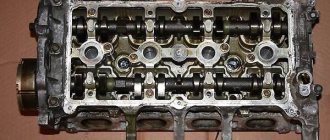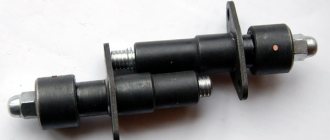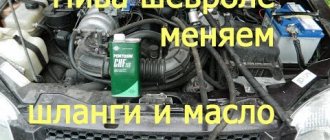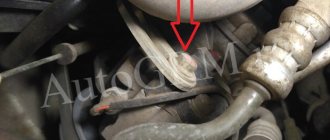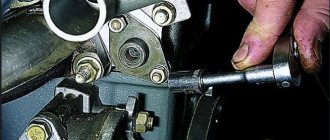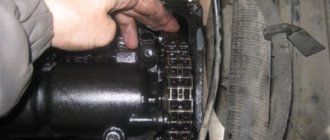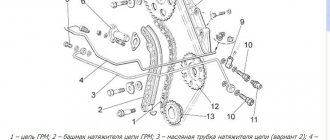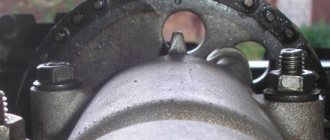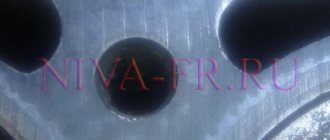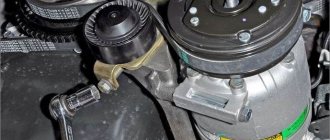Quick replacement of the timing chain on a Chevrolet Niva
Recently, an old friend of mine came to see me in his old Chevrolet Niva with the characteristic sound of an extended chain.
In addition to the timing kit, I had the foresight to purchase even a front cover gasket, a crankshaft oil seal and a kilo of marinated meat. I could not refuse such an offer. So, Niva Chevrolet replaced the timing chain and front crankshaft oil seal.
First, let the engine cool to an acceptable temperature. Remove the pipe by unscrewing the bolt by 10 and loosening the clamps.
Next, we unscrew the eight nuts by 10 and move aside the throttle cable and all the pipes that will interfere with us, remove the valve cover.
Remove the air conditioner belt by unscrewing the bolt 13 of the tension roller.
Then loosen three 13mm nuts and one bolt of the generator belt tension roller and remove it.
Now comes the fun part. To unscrew the pulley nut, we need a 38mm socket. Since the elongated head does not fit under a regular wrench (the radiator is in the way, but we don’t want to remove it), we use a pry bar, carefully sawed off from the hub key of some large car.
Everything fits perfectly. Unscrew the nut and remove the crankshaft pulley.
Unscrew the deflection roller.
We dismantle the reinforcing plate.
We unscrew the six nuts securing the front timing chain cover to the block and the three bolts securing it to the pan and remove it.
Set the top dead center. The key on the crankshaft should align against the mark on the block.
The mark for the camshaft sprockets is against the ebb of the camshaft housing.
Next, unscrew the oil supply pipe and two nuts 10 of the chain tensioner.
Next, unscrew the tensioner shoe, damper and remove the timing chain.
Compare the new and old timing chain. It could be worse.
New timing kit.
Reinstall the chain, guide and tensioner shoe. We tighten the chain by hand and check that the marks match.
To make it convenient for us to check the marks after installing the front timing cover, we find the factory mark on the crankshaft pulley and mark it with a white marker. This mark at TDC should be opposite the center of the crankshaft sensor.
We install the front cover, crankshaft pulley and tensioner. Let's check the marks again. We install all the removed parts in the reverse order of removal. Fill with fluids, start the engine and enjoy.
Checking the timing chain tensioner
By pulling the chain away from the sprocket, you can determine the degree of its stretch. A mandatory check of the degree of chain elongation must be carried out every 70-100 thousand kilometers .
It is necessary to check the timing chain tension every 100 thousand km.
If extraneous noise is noticeable in the engine compartment, it is important to pay attention to the chain before the end or start of such a run.
Location
This device is located in the Niva Chevrolet in the engine compartment on the passenger side. The hydraulic tensioner is located under the cooling system pipes on the engine block.
Mechanical chain tensioner. Main manufacturers.
main chain tensioners for -214 engine
The photo shows three main options common in Russia. The first product is made by the people and on the forums of the ANC “auto pilot”. The second product is manufactured by Rusmash, usually called the pilot. The third tensioner belongs to the designer Isaev, colloquially Isay. My team and I personally have installed several dozen of each type of tensioner on cars, so I have the right to talk about statistics and operating features. Something from behind the scenes. The first two tensioners belong to the pen of one person. Designer Igor Medvedev. On motor forums under the nickname Rhodes-M. As far as I know, patents for these inventions or utility models are registered in his personal name. I work together with this person on other projects, so the information about the designs and manufacturing features is first-hand.
Autopilot.
Principle of operation. Rack. Of the three, this is the undisputed leader. I have not noticed any shortcomings in operation. Cars with mileage of more than 150 thousand have already arrived where I installed autopilots from the very first batches. It is very convenient to work when replacing the camshaft; it does not need to be removed from the cylinder head. Flaw. It is difficult to find an “original” that has passed quality control. Medvedev left and the quality of input immediately dropped greatly. The cost of production has become cheaper.
Pilot.
The operating principle is a toothed rack. Good quality tensioner. The big brother of "autopilot". Stable quality. It is also possible to work without removing it from the cylinder head. The main disadvantage is the huge percentage of fakes on the market. This tensioner was the first successful design, and the Chinese grabbed it. If Autopilot is completely impossible to find, then Pilot is very difficult to find “original”. Based on the St. Petersburg market, I estimate the prevalence of counterfeits for this tensioner at 70%. I work with Rusmash directly, so this as a “minus” is insignificant.
Isaiah.
The operating principle is a clock spring. To avoid questions and insinuations, I contacted the designer directly and in 2022, we installed several dozen of them. The main disadvantage of the product, which the designer passes off as its advantage, is that there are no precision parts. When the rod doesn't move out too much, everything is fine. When the chain is worn out and the rod goes beyond half, it “walks” quite a lot. If we are talking about a production engine without “pretensions” for tuning, this may be acceptable. If the engine is “more serious” this is unacceptable. The tolerance for axial “walking” of the chain and sprockets in the timing tract is only 0.3 mm.
Summary
. We try to install Autopilot (if available) on tuned cylinder heads. For the most part, we work with Pilot, but if a client, based on forums or his own views, asks to install Isai, then we do not dissuade him. For double-row chains and -213 engines the situation is similar.
chain tensioner Pilot for 21213
Timing belt 21213, specifics
single-row timing belt 21213
The photo shows a single-row timing belt 21213, which has already been checked and run-in. Set contents:
I'll try to explain why the new kit is better. The difference in losses between the SAME single-row and double-row circuits in terms of efficiency (efficiency) is relatively small. According to theory, about 4-5%. But we have an “ace of trumps” in our pocket. The double-row chain in timing belt 21213 is bush-type, that is, the roller does not rotate, the so-called “heavy chains”. The single-row chain that goes to this timing belt is a bush-roller chain, the rollers rotate, these are “light chains”. But in this case, the difference in friction losses is no longer a few percent, but tens of percent. There is a separate article about this bushing-roller chain. And of course, friction losses on the rubber and plastic shoe of the tensioner are clearly not in favor of the old design. Now about the chain tensioner for this unit. I recommend installing “Rusmash”. The point is this: the tensioner shoe 21213 has an iron base, and the shoe 21214 is plastic, and the TZA tensioner, with its sharp nose, will slowly break it. Mechanical tensioners were discussed in more detail earlier.
How to install a hydraulic tensioner on a 409 engine
The engine has two hydraulic tensioners of the same design - for the upper and lower chains
Since hydraulic tensioners constantly keep the chains in tension, regardless of chain stretch and shoe wear, there is no need to adjust chain tension during operation.
The hydraulic chain tensioner device is shown in Figure 1.
Plunger 4 is installed in housing 5. A spring 6 is inserted into the plunger, which is compressed by a screw plug 1.
A check ball valve 2 is installed in the plug.
The plunger is fitted with locking ring 3 and retaining ring 7. In the figure, the hydraulic chain tensioner is shown in an inoperative (“charged”) state, when the locking ring keeps the plunger from moving.
In order to bring the hydraulic tensioner into working condition (“discharge” it), you need to press the end of the plunger so that the locking ring moves into the groove of a smaller diameter on the plunger, then under the action of the spring the plunger will move out of the body.
The hydraulic tensioner is installed on the engine in a “charged” state.
Under the action of the spring and oil flowing through the valve from the engine lubrication system, the plunger presses on the tensioner shoe and maintains the chain in tension.
As the chain stretches and the tensioner shoe wears, the plunger moves further out of the body, the locking ring moves into the next annular groove on the body, preventing the plunger from moving in the opposite direction.
When the chain hits the tensioner shoe (for example, when the engine operating mode changes), the plunger moves back into the body to the width of the groove under the locking ring. At the same time, it compresses the spring.
In addition, the valve closes and additional damping occurs due to the fact that oil is squeezed out through the gap between the plunger and the body.
You will need: a 12mm wrench, a screwdriver.
1. Holding the hydraulic tensioner cover (it is pressed from the inside by the tensioner), use a 12mm wrench to unscrew the two bolts.
2. Remove the cover and take out the hydraulic tensioner.
We install the hydraulic tensioner in a “charged” state, lubricating the channel in the cylinder head and, if necessary, replacing the torn gasket.
After installation, we bring the hydraulic tensioner into working condition - “discharge”.
“Charging” the hydraulic tensioner
If there is no mandrel for assembling the hydraulic tensioner or it is not possible to make one, you can assemble the tensioner as follows.
1. We bring the jaws of the vice together, leaving a gap of 19 mm between them.
Do not clamp the tensioner body in a vice.
When disassembling two hydraulic tensioners at once, do not confuse their plunger pairs, since they are selected with a certain clearance.
2. Install the tensioner body in a vice, like in a wrench, using a screwdriver with a wide blade.
3. turn out the valve.
4. Remove the spring from the housing
5. Remove the plunger.
We wash all parts in gasoline or kerosene, blow with compressed air and lubricate with engine oil.
6. From a steel sheet 0.8-1.0 mm thick, cut out a strip (10-15 mm wide and 25 mm long).
Using round-nose pliers or a mandrel, bend it into a ring with a diameter similar to that of a plunger.
7. Using the manufactured mandrel, we press the spring in the hydraulic tensioner housing.
8. Install the plunger into the body.
9. If necessary, use a thin screwdriver to guide the locking ring.
10. Use a screwdriver to press the bottom of the plunger until it stops.
11. We install a spring in the plunger, and the body itself in a vice.
12. Overcoming the resistance of the spring, we wrap the valve into the hydraulic tensioner housing.
13. For a correctly charged tensioner, the plunger should be completely inserted into the body.
Use a screwdriver to tighten the valve, holding the body in a vice (as during disassembly).
Do not press on the protruding end of the plunger, and after installing it in the channel of the block head, do not press on the tensioner itself.
Discharging the hydraulic tensioner
After installing the hydraulic tensioner on the engine, it must be brought into working condition - discharged. For this:
1. Using a 12mm wrench, unscrew the plug from the hydraulic tensioner cover.
2. Using a screwdriver through the hole, press the tensioner, which, when “discharged,” will push it out.
3. Put the plug in place.
This is what an “undischarged” hydraulic tensioner looks like.
Source
Mechanism characteristics
This element performs the function of adjusting the chain tension in the gas distribution mechanism drive. It is installed on all cars with this drive. The hydraulic chain tensioner compensates for low tension. Over time, the part wears out. When the motor is running, the chain constantly rotates and tends to stretch. It gets to the point where the part jumps one or more teeth. As a result, incorrect gas distribution occurs. As a result, late or early closing of the intake and exhaust valves occurs. Chain stretching is completely normal. Over its lifespan, it can stretch one to two centimeters. The hydraulic chain tensioner smoothes out this stretching.
Replacing the chain tensioner on VAZ 21213, VAZ 21214, VAZ 2131
Welcome! Chain tensioner - as is already clear from its name, it is only needed to tension the chain so that it does not loosen while the engine is running, but over time this part breaks for various reasons, this happens, sometimes the tensioner simply cannot withstand very heavy loads breaks, for example, if you keep the engine speed in the red zone for a long time, the tensioner cannot withstand and breaks, but it can also break because it is not very durable, for example, there are a lot of very bad tensioners on the market at the moment qualities that really fail very quickly and after that they will need to be replaced with a new one, and you will learn how to do this from this article.
Note! In order to replace the chain tensioner, you will need to stock up on: A basic set of wrenches, which will contain the most basic keys that you use almost everywhere in the car!
Where is the chain tensioner located? It is located on the side of the engine, it can be easily found by the way if you approach the car from the right side of the engine compartment (The countdown starts from the rear of the car to the front), there is also a battery installed nearby and there is a standard injection receiver in the form of curved pipes ( It is white), so when you stand on this very right side, look for the place indicated in the photo, this is the same tensioner.
Note! In the photo above there is one nuance, there is a completely different tensioner that was never installed on Niva cars, so don’t pay much attention to the shape of this tensioner, but just find out approximately where it is and that’s it! (There will still be a tube coming from the original tensioner, you will immediately understand, just take a closer look and it is all located almost in the middle part of the engine)
When should you change the chain tensioner? It changes only if it has become unusable, but how can you understand this, you ask? In general, when the tensioner becomes unusable, the car’s engine begins to run significantly louder, because the chain is weakened and thus there is such a roar as if you started the car with a diesel injection system, and not with a gasoline one, so if you hear something rattling in the engine, vibration may also appear, and by the way, this knocking should become less as the speed increases, that is, if the engine is noisy at idle and the chain rattles, then just give a little gas and if this knock goes away (the higher the speed, the weaker it should be knocking) then it is most likely really the tensioner, although many other parts could be to blame for this, but first you need to check it, since it is removed very quickly and is also checked accordingly.
Chain 21214, operation
This is the most important part in the revised article. Operators and mechanics have a slang expression about the operation of mechanisms and engines - “in operating or normal mode.” Let me explain with a comparison, like the son of a doctor. A person has blood pressure and pulse, which are considered normal. Let it be 120/80 and 60-70 beats per minute. And suddenly there was a pounding in my temples, my pulse quickened - hello high blood pressure. In both the first and second cases, you will walk, think, eat. But in the first case, your body and heart in particular are working “in working mode,” and in the second, the situation needs to be corrected. The doctor has a tonometer and a stethoscope in his hands, and the control unit has a knock sensor that listens to the noise level in the engine. In fact, its purpose is to measure detonation in the cylinders, but if there are still extraneous loud sounds in the engine, then it will add them to the overall picture. In professional diagnostic programs, it is possible to look at the data before entering the ADC (analog-to-digital converter). For this circuit, the knock sensor readings are lower than on Ditton, from 3% and higher. The service life of this chain is also higher than that of the Baltic one; operation “in operating mode” is more than 100 thousand km. Just install chain 21214, not on factory stamped sprockets, but on turned sprockets, with teeth made on a gear-cutting machine, otherwise there will be no fun. It is for this reason that I do not recommend purchasing a chain separately. Or at least with a set of sprockets, or better yet a complete timing belt set.
Is it possible to repair the old one?
An old hydraulic chain tensioner can be repaired in 60 percent of cases. But first you need to make sure that it is faulty. To do this, press the spherical end of the element with your finger. If it does not press, then the tensioner is jammed.
View gallery
This occurs due to the skew of the locking ring. It has small burrs at the ends of the cut. They are the ones that interfere with the operation of the element. The disassembled tensioner must be thoroughly washed in kerosene and the locking ring replaced. Its outer diameter is 16.6 by 3 millimeters. The ring can be made from spring wire. It happens that the ball valve fails - it allows excess oil to pass through. To check its tightness, you need to remove the plunger and spring from the housing. Insert the latter with the end (spherical) part into the housing hole. Press the opposite end of the element with your finger. If there are large traces of oil leakage, the part must be replaced. From the factory, small discharges are allowed through two marks on the end of the tensioner housing. They serve to remove air from the inside of the mechanism. You can try to wash the element, thereby restoring it. But the result is not always effective. To do this, you need to wash the ball valve in gasoline or kerosene, pressing it with a thin wire through the oil hole. If flushing does not produce results and the element still leaks oil, it should be replaced.
How does it work?
The principle of operation of the element is based on the operation of a spring. As oil from the line flows through the valve body, the plunger presses against the plastic tension shoe. Some engines use a lever with an asterisk. Thus, continuous contact of the surface of the working element is ensured. When engine speed changes, the element plunger moves back. The spring is compressed.
Damping of vibrations occurs due to the flow of lubricant through the plunger and body. The oil pressure is controlled by the hydraulic tensioner ball valve. When the chain is pulled, a plunger is pulled out of the housing. The retaining ring moves along the grooves to ensure proper tension. The unit also compensates for thermal expansion that occurs as the engine warms up.
Replacing the cylinder head gasket on a Niva Chevrolet car
- We remove the battery wiring and drain the antifreeze.
- We free the carburetor from cables and hoses.
- We dismantle the controller with voltage wires.
- Carefully remove the starter screen and heater tube from the manifold.
- Remove the antifreeze temperature sensor.
- Remove the brake booster hose.
- Remove the hoses from the cooling system and heater.
- Disconnect the camshaft and valve levers.
- We dismantle the chain and secure it.
- We unscrew the fasteners and remove the cylinder head with the pipe, carburetor and manifold.
According to reviews from Chevrolet Niva owners, you need to pay attention to the following subtleties:
- you should buy a metal seal as it is more durable and of higher quality;
- If the head fastener does not unscrew, you need to tap it with a hammer - this way you will minimally damage the surfaces and the key will not turn.
As you can see, replacing a gasket is not an easy task; you can do it yourself only if you have good general technical knowledge, skills and abilities. Remember, this is still the engine, the main part of the car. Before you do this, study the engine diagram well, the features of your car, do everything slowly, preferably in the morning with a fresh mind, because replacing a gasket is a feasible thing, but it requires attentiveness, scrupulousness and accuracy.
Issues of maintenance and replacement of tensioner shoes for VAZ cars
The tensioner shoe does not require maintenance during operation. However, over time, the shoe lining (or the working surface of the plastic shoe) wears out and loses its characteristics; such a shoe can no longer provide chain tension with the required force and requires replacement. The need to replace the shoe is indicated by the characteristic noise of the chain; in advanced situations, the chain may even skip. The shoe should also be replaced if it is deformed or mechanically damaged (this is only discovered during engine repair or maintenance, when the timing cover is removed).
In what cases is it necessary to change the cylinder head gasket on a Niva?
In principle, the element of the main cylinder block in question does not have a certain resource, that is, the gasket is replaced when it is damaged, which, however, usually occurs after 60,000 or 80,000 km. A breakdown is indicated by:
- air entering the antifreeze circulation system;
- lack of operating pressure in the combustion chamber of the air-fuel mixture;
- the presence of coolant in the lubricant or, conversely, the latter in the antifreeze (an oil film appears in the expansion tank).
All these problems lead to unstable operation of the Chevrolet engine.
In these situations, the gasket must be replaced immediately.
How to detect a fault
You can detect a weakened tensioner on a Chevrolet Niva by checking the chain pulls away from the sprocket. But such a check requires removing the protective casing from the car, which is extremely irrational in cases of uncertainty about the proper operation of the tensioner. Therefore, it is recommended to carry out a mandatory check of the chain for tension after 60-100 thousand km.
But, if the driver notices a rustling sound in the hood area, which resembles the sound of a diesel engine, then it is important to pay attention to this before the trip. This evidence of a rustling sound indicates that the chain has become loose and is hitting the teeth of the sprockets. Therefore, having discovered such a characteristic sound, it is worth urgently checking the tension.
Source
Manual chain tension
To eliminate the characteristic knocking sound of the chain drive in the valve cover area without changing the element itself, you can manually tighten the part. Let's look at how this procedure is performed using the example of a VAZ-2106 car. Here a sprocket is used in the tensioner.
View gallery
So, first you need to remove the air filter with housing and casing. Next, unscrew the tensioner (not all the way) and make 2-3 revolutions of the crankshaft. This can be done with a regular key, setting it to the third position. After several rotations of the crankshaft, the chain drive is engaged. Next, check the level of its tension by pressing your finger on the links. It should not sag by two or more centimeters. When the chain is properly tensioned, the hydraulic tensioner is tightened and the attachment is assembled in the reverse order. This procedure must be repeated whenever knocking noises appear in the engine compartment.
Hydraulic chain tensioner. The genuine pain of the domestic auto industry
Hydraulics, as you know, is a science that loves precision. The diameters of holes and bushings are ideally adjusted to microns, valves work reliably like clockwork and high requirements for the purity and quality of the working fluid (in our case, oil). Alas, when it comes to cheap domestic spare parts, the path to hell is paved with good intentions, such as the use of a progressive hydraulic tensioner for Lada 4x4 engines.
It would seem like a finely tuned automatic system. No periodic adjustments or diagnostics for you: the plunger reliably self-locks at working cut-offs until chain wear increases and additional force becomes necessary to tension it. Alas, when it comes to domestic spare parts, all this is good only in theory.
Replacing the hydraulic tensioner.
When a chain stretches, you cannot limit yourself to just replacing the tensioner. For high-quality repairs, it is also necessary to change the gasket seals and chain.
To replace, you will need the following procedure and set of tools:
- a 10mm wrench to disconnect the fitting of the oil supply tube to the hydraulic tensioner.
- After this, the fitting is loosened and the tube is pulled upward.
- Using a 10mm wrench, remove the nuts that hold the tensioner.
- After this, the device can be removed and a new one installed.
- An old timing belt tensioner cannot be repaired. Before installing a new spare part, the seat must be coated with sealant to prevent oil leakage.
Installing a new part is carried out in the reverse order:
- The tensioner is inserted into the seat. The part must be identical to that recommended by the manufacturer.
- Tightened with two nuts. When tightening, you do not need to exert excessive force so as not to break the thread.
- We fix the tube for supplying oil to the hydraulic tensioner.
It is important to remember that without replacing the timing chain, the problem may not be corrected, since the chain may be stretched so much that this wear will not be compensated by a new tensioner. https://www.youtube.com/watch?v=Rs7i0Ox25pk
How to change?
If the symptoms described above are observed, an urgent replacement of the hydraulic chain tensioner is necessary. To do this we need a new element, as well as a set of heads. Using a 10mm wrench, unscrew the fitting of the cylinder head cooling tube and move it upward.
Next, we find two fastening nuts for the tensioner itself. We unscrew them with the same key. We take the protruding part of the mechanism with our hands and remove it from the seat. It is worth noting that the hydraulic chain tensioner has its own gasket, which also needs to be replaced. Before installing a new element, carefully coat the seats with silicone sealant. Install the gasket and tighten the bolts. By the way, before installation you need to remove the transport stopper. This element is needed to prevent the tensioner from discharging (so that the plunger does not come out of the body) during transportation. To “charge” the element and bring it into working condition, after assembly you need to press the negative screwdriver onto the part with great force. As a result, the hydraulic tensioner housing, under the action of the spring, will move into the cover until it stops.
The plunger itself will produce the proper chain tension through the sprocket or shoe (depending on the design features of the engine). Before “charging” you need to carefully tighten all the bolts. Otherwise, this will lead to premature wedging of the element. Don't forget to reinstall the fitting. After installation, start the engine and check it for extraneous sounds.
Removing the cylinder head cover
Place the machine on a pit or ramp.
First, the holders of the brake booster pipe and the throttle valve drive cable should be disconnected from the cylinder head cover. They are mounted on special brackets on the left and right sides of the block.
Next, use a 10mm wrench to unscrew the bolt securing the air duct couplings. Move it aside. Next, using a screwdriver, slightly loosen the clamp of the crankcase ventilation pipe, which connects it to the air duct. Now use a 10mm socket to unscrew the bolts holding the cylinder head cover. The order is not important here.
OLYMPUS DIGITAL CAMERA
After that remove:
- brackets for the throttle cable and motor screen;
- lid pressure washers;
- ventilation and air hoses.
Next, all that remains is to remove the cylinder head cover.
Hydraulic chain tensioner for VAZ 21214 device and principle of operation
general information
It has long been known that the quality of car parts produced at the AvtoVAZ plant is not of a high level. And timing parts are no exception. The chain has to be constantly tightened, almost every thousand kilometers. A hydraulic chain tensioner will help get rid of this problem. It is this device that we will talk about in this article. Let's look in detail at the operation scheme and replacement of the device.
Scheme of work
The figure below shows a diagram of the operation of the spring-hydraulic chain tensioner of the VAZ 21214 car. 1 – camshaft star; 2 – timing chain; 3 – chain damper; 4 – auxiliary device drive star; 5 – crankshaft star; 6 – tensioner “shoe”; 7 – hydraulic chain tensioner; 8 – line fitting; 9 – oil line; 10 – adapter fitting; 11 – oil pressure sensor (emergency).
Replacing the drive chain hydraulic tensioner
Detailed instructions with photos for replacing the hydraulic chain tensioner: The hydraulic tensioner is located under the cooling pipes in the front of the cylinder head.
Assembly is carried out in reverse order. If after all the manipulations you start the engine and still do not hear the rattle of the chain, then everything has been done correctly.
Prices for hydraulic tensioner VAZ 21214 range from 400 rubles. up to 900 rub. Depending on the region. But there is no shortage of this device on store shelves.
How to determine if a chain drive is faulty
Unlike the timing belt drive, which is located outside the engine, the chain with gears is located inside the power unit and is completely hidden from view. On the one hand, this is a plus: the mechanism makes less noise and is generously lubricated with engine oil, which increases its service life. On the other hand, without removing the valve cover it is impossible to visually assess the technical condition of the unit.
The first sign of a chain drive problem is a rumbling sound coming from under the cover when the power unit is operating. The rumble of a weakened chain cannot be confused with anything; it is heard from the side where the gas distribution mechanism is located.
Loosening with a gap of up to 1 cm allows the chain to jump when starting the engine
Having heard such a sound, the car owner should check the condition of the drive so as not to encounter big troubles associated with engine repair. There are 2 ways: immediately go for diagnostics to the nearest car service center, or remove the valve cover yourself and make sure that the section of the chain near the camshaft gear is loose. Worsening tension is caused by the following reasons:
- due to stretching to such a length that the tensioning device is unable to pick up the slack;
- due to a faulty tensioner;
- the damping plate is worn out or torn;
- Due to the high mileage of the car, all the parts of the mechanism have worn out - the chain, gears, tensioner and damper.
If an old-style mechanical tensioning device is installed in the car engine, then when the described symptoms appear, the first action is to tighten the chain with its help. To do this, simply loosen the outer nut holding the plunger spring and manually turn the crankshaft 1-2 turns. After which the nut is tightened again.
Old VAZ 2101–07 engines have a mechanical tensioner with a nut
Modern automatic hydraulic tensioners are not designed for manual adjustment and must be replaced if they break. You can verify that the element has failed only by removing it or disassembling the entire timing belt assembly. The same applies to the damper - on most cars, its wear can only be assessed when the mechanism is disassembled.
Ignoring the rumbling noise made by the chain will sooner or later lead to motor failure. The severity of the consequences depends only on your luck.
Replacement process and tightening torque
Required Tools
To carry out this work on replacing the cylinder head gasket of the Niva Chevrolet and tightening the cylinder head bolts, you should prepare:
- Phillips and slotted screwdriver;
- set of open-end wrenches;
- torque wrench.
Without the last element, tightening the cylinder head pulleys will be impossible.
Step-by-step instruction
- Initially, of course, you need to dismantle the cylinder head cover itself.
- Then place a container under the bottom of the car to collect the waste refrigerant. Unscrew the drain plug and drain the antifreeze.
- Then you should disconnect the throttle cable from the receiver and assembly.
- After this, the timing pulley should be removed along with the bearing housing.
- Next, we dismantle the valve lever, and then unscrew the lever supports themselves. Also dismantle the engine fluid supply ramp to the hydraulic supports.
- Now you need to disconnect the cable harness from the TPS. In the same way, disconnect the wiring from the idle speed sensor and antifreeze.
- You need to squeeze the plastic clip and then disconnect the connector with the wires that are designed to power the injectors. Here you also need to remember to disconnect the wiring harness from the knock sensor.
- Now disconnect the high voltage cables from the spark plugs. Also disconnect the cable that powers the engine temperature control device.
- Slightly compress and disconnect the exhaust pipe from the intake manifold. Then the upper screw securing the inlet tube spacer and, slightly loosening the lower screw, the spacer should be moved to the side.
- The clamp should be loosened slightly, then the adsorber purge pipe should be disconnected from the throttle assembly.
- The clamps must be loosened and the cooling system pipes must be disconnected from the cylinder head.
- Using open-end wrenches, you now need to disconnect the fuel lines. To do this, unscrew the nuts of the fuel hoses intended for draining and supplying gasoline.
- Now use a wrench to remove the top screw that secures the rear intake tube brace. The bottom screw should also be loosened a little. After these steps, the spacer must be removed to the side.
- When all the above steps have been completed, the camshaft pulley drive chain tensioner should be removed.
- Then dismantle the brackets that secure the power steering device.
- Now you can remove the chain with the timing pulley star.
- After this, using a socket with an extension, you will need to unscrew the screws securing the cylinder head, and then dismantle it.
- The cylinder head gasket can now be removed. Mount a new component in its place, having previously lubricated its perimeter with sealed glue. Actually, at this point the work on replacing the cylinder head gasket in the Chevrolet Niva can be considered completed. All further work on assembling the power unit must be performed in the reverse order. But that is not all. To ensure a reliable fit of the cylinder head to the block itself, you need to correctly tighten the screws and maintain the tightening torque.
- The procedure itself consists of several stages. First of all, using a torque wrench and following the order indicated in the diagram, you need to tighten the screws from the first to the tenth. In this case, the tightening torque of the Niva Chevrolet cylinder head should be 20 Nm.
- Next, when all the bolts are tightened in turn, you need to tighten all the cylinder head screws again. The tightening torque should now be 69.4–85.7 Nm. The last, eleventh pulley needs to be tightened to 31.4–39.1 Nm.
- After these steps, the screws marked with numbers from one to ten need to be turned 90 degrees, and then, when they are all screwed, you should repeat the procedure and turn them again 90 degrees. At this point, the screw tightening procedure can be considered complete.
6. Remove the cylinder head gasket and replace it. If all the steps were performed correctly, then after replacing the component you will no longer have the problem of engine fluid getting into the antifreeze and vice versa. But keep in mind: everything must be done according to the steps specified in this manual.
If the screw is not tightened, the cylinder head will not fit tightly to the block. This is fraught with engine fluid leakage. If, on the contrary, you overtighten the pulleys, this can cause cracks to form on the power unit. If microcracks appear, then you will have to either weld the cylinder head or replace it. Therefore, before you begin such repairs, think carefully - can you do everything right?
Product added to bookmarks!
APPLICABILITY: VAZ 21214 (Niva), 2123 (Niva-Chevrolet) engines.
Automatic chain tensioner "RUSMASH" "PILOT"
The automatic chain tensioner (ANT) “Pilot” is designed for installation instead of the standard chain tensioner on VAZ cars of the classic family. ANC “Pilot” does not require maintenance after installation and fully automatically tightens the car chain as it stretches. It differs favorably from its analogues in that it does not require an oil line, which eliminates its chafing and loss of oil pressure. There are no plunger elements in the design, which eliminates jamming of the tensioner! The tensioner moves in increments of only 1 mm, allowing optimal chain tension monitoring. Due to the adjusted spring tension force, the ANC “Pilot” practically does not wear out the chain tensioner shoe. As a result of the installation, engine noise is significantly reduced, and the service life of all timing components is increased due to correct chain tension.
Service
During operation, the Pilot operates automatically and does not require adjustment operations or maintenance.
Guarantee
The warranty period for the product is set for the entire service life of the vehicle.
The result of using an automatic tensioner
– The service life of all timing drive parts is increased several times due to constant monitoring of chain tension and eliminating the possibility of increasing parasitic loads in free chain branches. – Improved engine performance due to precise valve timing. – The chain is tensioned regardless of whether the engine is running or not.
Replacing the timing drive and installing an automatic tensioner “pilot” in a Chevrolet Niva (VAZ 2123)
Equipment in the form of a special wrench for 38 for VAZs
Wrench for 38 VAZ for pulley nut
Which didn’t fit due to the special shape of the pulley, so a 32x38 balloon was bought at a truck store for 650 rubles
Truck balloon
And a mega head for 38 was made
PREPARATION I removed the radiator with fans according to the manual. He didn’t pull him out, but took him forward. I took off the alternator belt. I removed the pump. I removed the air duct. I removed the tension roller. I removed the bypass roller by snapping off the cap with a screwdriver and unscrewing the bolt. I disconnected all the connectors, pipes, and throttle cable from the valve cover to free up working space. I removed the engine boot and protection from below. Unscrewed the valve cover
Timing cover
I dismantled the hydraulic tensioner, for which I first removed its oil line using a brake pipe wrench.
Hydraulic tensioner oil line
Using a 22 key, I unscrewed the emergency oil pressure sensor from the tee. I unscrewed the tee with a spark plug wrench.
In place of the tee, I screwed in the emergency oil pressure sensor (I immediately screwed in a new one).
I unscrewed the two nuts of the hydraulic tensioner, there was a problem with the top nut, first I tore it off with a small 10 socket, then I put on a 10 socket wrench and twisted the tube with pliers.
Hydraulic tensioner and removal tool
I removed the hydraulic tensioner, unscrewed the shoe bolt, and removed it. I removed the camshaft sprocket, chain and the remaining 2 sprockets.
Replacing the hydraulic chain tensioner on Niva
The new model Nivki, which is better known to us as the Chevrolet Niva, cutting through domestic roads, inherited the above-mentioned disease from its older brother, the VAZ 21214, which, in turn, is now proudly called Lada 4x4. But the problem is not as scary as its description. In order to keep the power unit in good condition, it is enough to always keep your finger on its pulse: listen to extraneous sounds, regularly carry out maintenance after 60-100 thousand kilometers and not let the problem take its course.
Please note that simply replacing a used VAZ 21214 hydraulic tensioner with a new one is not the right way out of this situation. At a minimum, it is necessary to change the timing chain, which is clearly in critical condition, disposable rubber sealing gaskets in the form of rings and oil seals
And, if replacing such a simple device as a hydraulic tensioner does not present any particular problems on a VAZ 21214, then as for the timing chain, this is already a reason for a separate article.
The part designed to regulate the chain tension in a Niva Chevrolet car is called a timing belt (gas distribution mechanism) hydraulic tensioner. In the Chevrolet Niva timing system, the hydraulic tensioner performs a very important function, so engine operation without such a part is simply impossible. Over time, all parts of a car tend to wear out.
Rotating parts of cars are especially prone to wear, weakening, stretching and breaking. This part includes the timing chain, which stretches over time and wears out. Chain stretching is normal but must be addressed. It is to eliminate chain stretch that a hydraulic tensioner is installed in the timing system. It has a wear property that is detected by loosening the chain to half the sprocket tooth.
1 – tensioner body; 2 – valve unit; 3 – check valve ball; 4 – limit pin; 5 – tensioner plunger; 6 – volume limiter; 7 – plunger spring; B – working cavity; C – installation groove; D – hole; E – reserve cavity.
Oil from the lubrication system through tube 3 (see Fig. 2-11) enters cavity “E” (Fig. 2-46) of the tensioner, then through hole “D” and valve assembly 2 enters working cavity “B” and presses onto plunger 5. In tensioner body 1 there is a hole with a diameter of 1 mm for bleeding air from cavity “E”.
The diametrical gap between body 1 and plunger 2 should be 0.018–0.024 mm and is measured as the difference between the maximum measured diameter of plunger 2 and the minimum measured diameter of body 1.
During repairs, the tensioner body and plunger form a pair in which replacing one part with another after selecting the gap is not allowed. Plunger 2 must move in body 1 without jamming by a stroke of 16 mm.
When installed on the engine, the tensioner must be free of oil, pin 4 must not protrude from the housing.
As can be seen in the figure, the device has a cylindrical shape; it is screwed on the outside with a lid with a small hole through which oil flows. Inside the device there is a small ball and a spring, which ensures free flow of oil in one direction and does not release it in the opposite direction.
Inside the device body there is a cylinder with rings. On the inside of the housing walls there are spiral notches that have an inclined shape. When the chain is loosened, the piston, under pressure in the housing, moves to a certain notch on the housing wall. When the tension occurs, the body notches do not allow the piston to take its original position. It is carried out by engaging the piston rings with one-sided notches. This is how the tension device works.
Hydraulic chain tensioner. The genuine pain of the domestic auto industry
Hydraulics, as you know, is a science that loves precision. The diameters of holes and bushings are ideally adjusted to microns, valves work reliably like clockwork and high requirements for the purity and quality of the working fluid (in our case, oil). Alas, when it comes to cheap domestic spare parts, the path to hell is paved with good intentions, such as the use of a progressive hydraulic tensioner for Lada 4x4 engines.
It would seem like a finely tuned automatic system. No periodic adjustments or diagnostics for you: the plunger reliably self-locks at working cut-offs until chain wear increases and additional force becomes necessary to tension it. Alas, when it comes to domestic spare parts, all this is good only in theory.
The principle of operation of the hydraulic tensioner on Niva
Without once again venting in angry odes towards the domestic automobile industry, we will simply summarize that the problem of extraneous noise from the internal combustion engine, the main cause of which is often the hydraulic chain tensioner on the VAZ 21214, exists and we have to deal with it somehow. And, as we know, there is no smoke without fire, and another common problem with the hydraulic chain tensioning system is the failure of the oil-conducting system. Killed by running a dry internal combustion engine sounds like a bad dream. What to do and how to continue to live?
